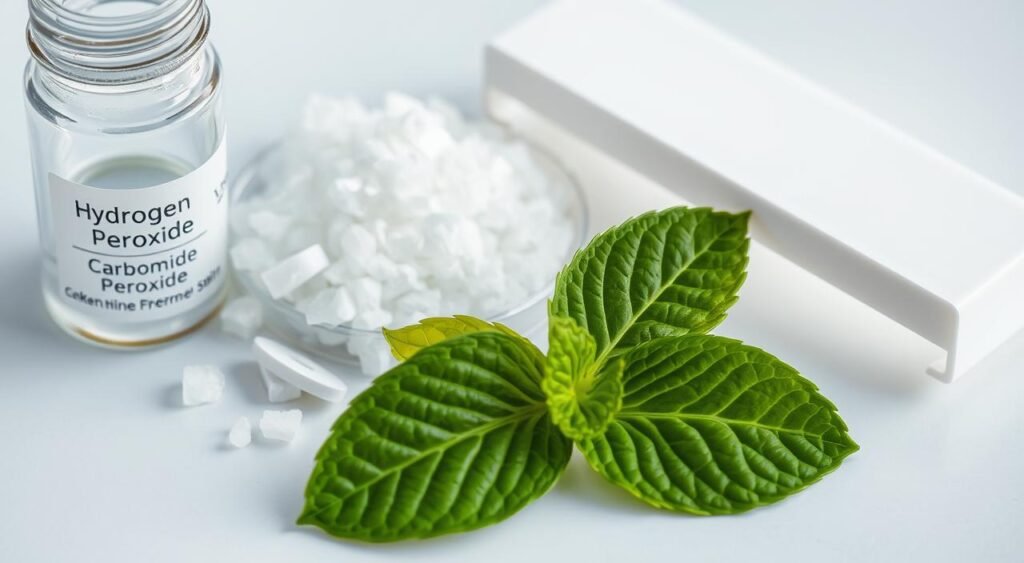In today’s world, having a bright, white smile is seen as beautiful. So, it’s no surprise that 37 million Americans used teeth-whitening products in 2020. Many chose the easy option of over-the-counter whitening strips. But, are whitening strips bad for your teeth?
Whitening strips use ingredients like hydrogen peroxide or bleach to remove stains on the surface. But they don’t fix deeper stains. Before you try to whiten your teeth at home, talk to your dentist. Some ingredients, like chlorine dioxide, can harm your tooth enamel and cause long-term problems.
Hydrogen peroxide in whitening products can also hurt the dentin layer under the enamel. This can make your teeth more sensitive and lead to bigger issues. With these risks in mind, think carefully before using whitening strips to protect your teeth’s health.
Whitening Strips: How They Work
Many people choose over-the-counter (OTC) teeth whitening strips for a brighter smile. But what makes them work? It’s all about the active ingredients they have.
Revealing the Active Ingredients
Hydrogen peroxide or carbamide peroxide are common in whitening strips. These chemicals break down stains on your teeth. They remove both internal and external stains.
The American Dental Association says these products can remove both kinds of stains. A 2020 review showed that strips work better than whitening toothpaste as an OTC option.
Strips have a sticky gel with the whitening agents. You put them on your teeth for 30 minutes, twice a day, for 2 weeks. This lets the ingredients work and remove stains, making your teeth look brighter.
But remember, strips mainly work on surface stains. For deeper stains, see a dentist. They can use professional treatments like custom trays or light-activated bleaching.
Are Whitening Strips Safe?
Teeth whitening is a big concern for many. Whitening strips are a popular choice for at-home use. But, people often wonder if they are safe. The answer depends on the ingredients and how you use them.
Whitening strips usually have hydrogen peroxide or carbamide peroxide. These ingredients help remove stains and discoloration. But, they can be risky if not used right.
- High amounts of these agents can harm the tooth structure. This can make teeth more prone to decay and cause sensitivity.
- Using whitening strips too much or for too long can irritate your gums. This leads to discomfort and swelling.
- Also, if you apply the strips wrong, some teeth might not get whitened evenly.
To keep whitening strips safe, follow the directions carefully. Don’t use them more than suggested or leave them on too long. This won’t make your teeth whiter faster and could harm them.
Whitening strips can be easy and cheap, but safety comes with careful use. Talking to a dentist can help you use these products safely. They can guide you on how to protect your teeth’s health.
are whitening strips bad for your teeth
Whitening strips are a popular choice for a brighter smile. They work well on surface stains. But, it’s key to know the risks they might bring.
The strips use hydrogen peroxide or carbamide peroxide. These can help and hurt your teeth’s health.

One big worry is tooth sensitivity. The peroxide can go deep into your teeth, making them feel sore. This is a big issue for those who already have sensitive teeth.
Using strips too much or wrong can also harm your teeth. It can wear away the enamel, leaving your teeth open to cavities. Always stick to the product’s guidelines.
To lessen risks, avoid strips with chlorine dioxide. It’s tough on enamel. Also, be careful with strips over 14% hydrogen peroxide. Always talk to a dentist before using them.
Whitening strips can make your teeth look better without costing much. But, think about the risks and benefits. Talk to your dentist to find the safest way to get the look you want without harming your teeth.
Comparing Whitening Strips to Professional Whitening
Effectiveness and Safety Considerations
When thinking about whitening your teeth, you might look at over-the-counter strips or professional treatments. Both can make your smile brighter, but they differ in how well and safely they work.
Professional treatments can make teeth up to 8 shades whiter right after one visit. Whitening strips, however, usually make teeth 3-6 shades lighter over two weeks. This is because professional treatments use stronger ingredients.
It’s important to think about safety too. Whitening strips with chlorine dioxide can harm your tooth enamel and cause permanent damage. Using strips too much can also make your teeth sensitive or even wear away the enamel. Professional treatments are watched closely by your dentist to keep your teeth and gums safe.
Professional treatments also work better on deep stains that whitening strips can’t easily reach. Talking to your dentist can help figure out why your teeth are stained and suggest the safest way to whiten them.
While whitening strips are cheaper and easier to use, professional treatments are better for lasting, safe, and even results. Talking to your dentist is the best way to get the smile you want.
Alternatives to Whitening Strips
If you’re worried about the risks of whitening strips, there are safer options. Whitening strips can damage your teeth over time. Luckily, there are natural ways to brighten your smile.
Try fluoride products, alone or with whitening, to rebuild your teeth and reduce sensitivity. A dentist can help you find the best whitening method for your teeth.
Natural remedies like baking soda, apple cider vinegar, and oil pulling are good alternatives. Baking soda makes a paste to remove stains. Apple cider vinegar can kill bacteria and fade stains. Oil pulling with coconut, olive, or sesame oil also removes stains and fights decay.

For a lasting solution, consider professional teeth whitening. In-office treatments can whiten teeth up to four shades in an hour. These results last longer than home treatments like whitening strips.
Your best choice depends on your dental health, budget, and what you prefer. By trying these alternatives to whitening strips, you can find a safe way to brighten your smile.
| Alternative | How It Works | Effectiveness | Pros | Cons |
|---|---|---|---|---|
| Baking Soda | Mixed with water to create a paste and brushed onto teeth | Moderately effective at removing surface stains | Natural, affordable, and readily available | May not be as effective as professional whitening treatments |
| Apple Cider Vinegar | Used as a mouthwash to eradicate bacteria and erase stains | Moderately effective at removing surface stains | Natural, affordable, and readily available | May be too harsh for some people and can erode enamel if used excessively |
| Oil Pulling | Involves swishing coconut, olive, or sesame oil in the mouth for 10-20 minutes | Moderately effective at removing stains and reducing tooth decay | Natural, inexpensive, and can improve overall oral health | Time-consuming and may not be as effective as professional whitening treatments |
| Professional Whitening | In-office treatments using stronger whitening agents and specialized equipment | Highly effective at making teeth up to four shades whiter in about an hour | Long-lasting results, dentist-supervised for safety | More expensive than at-home treatments, may cause temporary sensitivity |
Conclusion
Whitening strips are a popular choice for a brighter smile, but they may not be safe for your teeth. The main ingredient, hydrogen peroxide, can harm the enamel and dentin. This can cause sensitivity and harm your teeth in the long run.
It’s important to be careful when using whitening strips and follow the instructions closely. Talking to a dentist before starting any whitening treatment is a good idea. They can suggest the safest and most effective way for you. You might also want to look into other options like fluoride products or natural remedies.
When it comes to making your teeth look better, think about your overall oral health first. Knowing the risks and benefits helps you make a safe choice. Working with a trusted dentist ensures you get the best results without harming your teeth.
FAQ – Whitening Strips and Their Effects
Are whitening strips bad for your teeth?
Whitening strips can be safe or not, depending on what they contain. Strips with chlorine dioxide can harm tooth enamel. This increases the risk of decay and other issues. Even without chlorine dioxide, strips can still cause problems if not used right. It’s important to follow the instructions closely. Using strips too often or leaving them on too long won’t make teeth whiter faster. It will just increase the risk of damage.
What are the side effects of using whitening strips?
The most common side effect is tooth sensitivity. This can make eating or drinking hot or cold items uncomfortable. The hydrogen peroxide in these products can also harm the dentin layer under the enamel. This can lead to more sensitivity and harm the teeth’s health and structure.
How effective are whitening strips?
Whitening strips work by removing surface stains with an active ingredient like hydrogen peroxide or bleach. But they can’t fix stains that are deep inside the tooth. It’s wise to talk to a dentist before whitening your teeth at home.
How do whitening strips compare to professional whitening?
Professional whitening products have more hydrogen peroxide, up to 25-30%. This is much stronger than the 6-14% in over-the-counter strips. This higher strength can be risky for the dentin layer and cause sensitivity. A dentist can help find the safest and most effective way to whiten teeth for you.
Are there any alternatives to whitening strips?
There are weaker oxidizing agents that could be used instead of hydrogen peroxide. These might not work as well, though. Using fluoride products, alone or with whitening, can help protect the tooth structure and reduce sensitivity.








